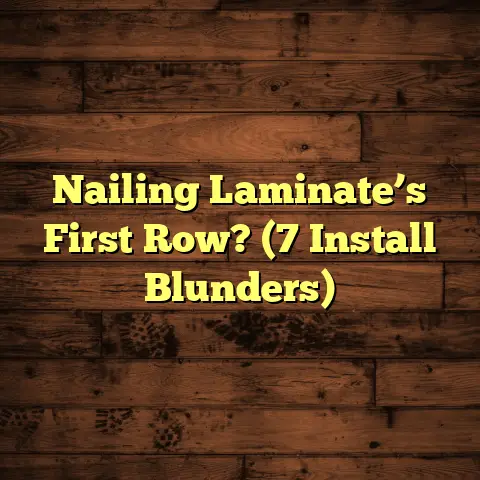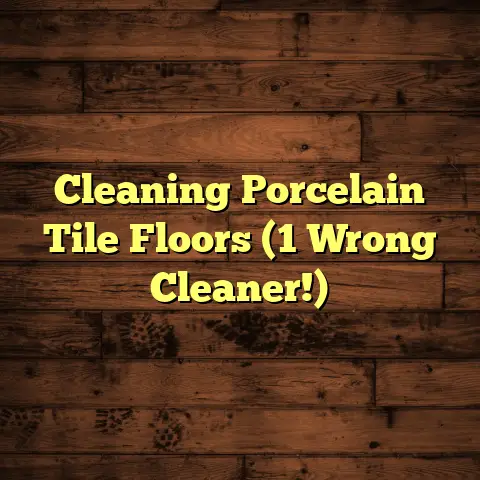Stop Laminate Floors Streaking! (2 Cleaning Blunders!)
I’ve been laying and fixing floors for many years.
And if there’s one thing that drives me bonkers, it’s seeing beautiful laminate floors ruined by streaks.
Laminate is fantastic – it looks great, it’s durable, and it’s generally easy to care for.
But I constantly see people struggling with streaks after cleaning, and it doesn’t have to be that way.
I’m going to let you in on a little secret: It almost always comes down to two major cleaning blunders.
Once you understand what they are and how to avoid them, you’ll be rocking streak-free floors in no time!
So, grab a coffee, and let’s dive in!
Section 1: Understanding
Laminate Flooring
Okay, let’s start with the basics.
What exactly is laminate flooring?
Basically, it’s a multi-layer synthetic flooring product fused together with a lamination process.
It typically consists of a high-density fiberboard (HDF) core topped with a decorative layer (that looks like wood, stone, or tile) and a protective wear layer.
Think of it like a super-durable photograph on top of a sturdy board.
One of the biggest advantages of laminate is that it’s much more affordable than hardwood or tile, and it’s also easier to install.
Plus, it’s pretty resistant to scratches, dents, and fading – making it a great choice for busy households.
Now, when it comes to cleaning, it’s important to understand the different finish types on laminate floors.
Some have a smoother, glossier finish, while others have a more textured, matte finish.
This can affect how cleaning products react with the surface and how visible streaks are.
So, why do streaks even happen?
Well, a few things can cause them.
First, there’s good old dirt and grime.
If you don’t sweep or vacuum regularly, that dirt gets ground into the floor when you mop, leaving behind a dull film.
Moisture is another big culprit.
Laminate floors aren’t waterproof, so if you use too much water when cleaning, it can seep into the seams and cause damage over time.
But even without causing damage, excess water can leave behind residue that dries into streaks.
And finally, the cleaning products themselves can be a major problem.
Using the wrong cleaner can leave behind a sticky residue or even damage the finish of your floor, leading to streaks and a dull appearance.
Section 2: Cleaning Blunder #1 –
Using the Wrong Cleaning Products
Alright, let’s get to the first big mistake I see people making: using harsh or unsuitable cleaning products.
I get it – you want to get your floors really clean, so you reach for the strongest cleaner you can find.
But trust me, that’s not always the best approach with laminate.
One of the most common offenders is vinegar.
I know, I know – everyone swears by vinegar for cleaning everything!
But here’s the thing: Vinegar is acidic, and while it can be great for cutting through grease and grime, it can also dull the finish of your laminate floors over time.
Plus, it can leave behind a hazy residue that’s really hard to get rid of.
Ammonia is another no-no.
It’s way too harsh for laminate and can damage the protective wear layer, making your floors more susceptible to scratches and stains.
And oil-based cleaners? Forget about it!
These leave behind a greasy film that attracts dirt and makes your floors look even worse than before.
I’ve even seen people using dish soap on their laminate floors!
While it might seem gentle, dish soap can actually leave behind a soapy residue that’s incredibly difficult to rinse off.
So, what’s going on here?
Why are these seemingly harmless cleaning products so bad for laminate?
Well, it all comes down to chemistry.
Vinegar, being acidic, can slowly break down the protective finish on your laminate.
Ammonia, being alkaline, can have a similar effect.
And oil-based cleaners and dish soap leave behind a residue because they’re designed to emulsify dirt and grease, not to be easily rinsed away.
This residue then attracts more dirt, creating a vicious cycle of streaking and dullness.
So, what should you use to clean your laminate floors?
Here’s my go-to list of safe and effective cleaning solutions:
- Laminate Floor Cleaners:
These are specially formulated for
laminate floors and are pH-neutral,
meaning they won’t damage the finish.
You can find them at most hardware
stores or online. Some popular brands
include Weiman, Bona, and Black Diamond. - DIY Solution (Water + Dish Soap):
Mix a few drops of dish soap into a
bucket of warm water. Dip the microfiber
cloth into the mixture and wring it
out until it’s just damp. - DIY Solution (Water + Rubbing Alcohol):
Mix equal parts rubbing alcohol and
water in a spray bottle. Lightly mist
the floor and wipe with a clean,
dry microfiber cloth. The alcohol will
help the water evaporate quickly,
preventing streaks.
Example: Comparison of Cleaning Products
| Cleaning Product | Potential Effect on Laminate | Reason |
|---|---|---|
| Vinegar | Dulls finish, hazy residue | Acidity breaks down protective layer |
| Ammonia | Damages wear layer | Harsh alkalinity |
| Oil-Based Cleaners | Greasy film, attracts dirt | Leaves behind residue |
| Dish Soap | Soapy residue | Difficult to rinse off completely |
| Laminate Floor Cleaner | Safe and effective | pH-neutral, specially formulated |
Section 3: Cleaning Blunder #2 –
Over-Wetting the Floors
Okay, now let’s talk about the second major cleaning blunder: using too much water or excessive damp mopping.
I know it’s tempting to really soak your mop to get your floors squeaky clean.
But with laminate, less is definitely more.
As I mentioned earlier, laminate floors aren’t waterproof.
The HDF core is particularly susceptible to moisture damage.
If water seeps into the seams between the planks, it can cause the core to swell, leading to warping, buckling, and even delamination (where the layers of the laminate start to separate).
And even if you don’t cause permanent damage, over-wetting your floors can still lead to streaks.
When you use too much water, it takes longer for the floor to dry, giving dirt and residue more time to settle and create those annoying streaks.
So, how do you properly dampen your mop or cleaning cloth?
Here’s my technique:
If you’re using a traditional mop, dip it in your cleaning solution and then wring it out really well.
You want it to be damp, not dripping wet.
If you’re using a microfiber cloth, spray it lightly with your cleaning solution and then wipe the floor.
Again, you want the cloth to be damp, not soaked.
I always recommend using a spray bottle with any cleaning solution.
This will prevent you from using too much liquid and help you control the amount of moisture on your floors.
Another important thing to consider is cleaning frequency.
You don’t need to mop your laminate floors every day!
In fact, over-cleaning can actually do more harm than good.
I recommend mopping once a week, or more often if you have pets or heavy foot traffic.
For daily maintenance, simply sweep or vacuum to remove loose dirt and debris.
This will prevent dirt from getting ground into the floor and reduce the need for frequent mopping.
Section 4: How to Properly
Clean Laminate Floors
Alright, now that we’ve covered the two major cleaning blunders, let’s talk about how to properly clean laminate floors without streaking.
Here’s my step-by-step guide:
- Step 1: Gather the right tools and materials.
You’ll need:- A broom or vacuum cleaner
- A bucket
- Your chosen cleaning solution
- A damp mop or microfiber cloth
- A dry microfiber cloth
- Step 2: Sweep or vacuum to remove loose dirt and debris.
This is a crucial step! Don’t skip it!
You want to get rid of as much dirt
and grime as possible before you start mopping. - Step 3: Prepare the cleaning solution (either store-bought or DIY).
Follow the instructions on the label
if you’re using a store-bought cleaner.
If you’re using a DIY solution, mix
it according to the recipes I shared earlier. - Step 4: Apply the cleaning solution using a damp mop or microfiber cloth, avoiding excess water.
Remember, less is more! Wring out your
mop or cloth really well before you
start cleaning.
Work in small sections, and avoid
leaving puddles of water on the floor. - Step 5: Dry the floor immediately after cleaning to prevent streaks.
This is the key to streak-free floors!
Use a clean, dry microfiber cloth to
buff the floor dry as you go.
This will remove any remaining residue
and prevent streaks from forming.
Example: Step-by-Step Cleaning Visual
| Step | Description | Image (Imagine a corresponding image here) |
|---|---|---|
| 1 | Gather tools: broom, bucket, cleaner, mop, dry cloth | (Image of cleaning supplies) |
| 2 | Sweep/Vacuum floor | (Image of someone vacuuming) |
| 3 | Prepare cleaning solution | (Image of mixing cleaner) |
| 4 | Damp mop floor | (Image of damp mopping) |
| 5 | Dry the floor with a microfiber cloth | (Image of drying the floor) |
Section 5: Preventative Measures to
Maintain Streak-Free Floors
Okay, so you know how to clean your laminate floors properly.
But what about preventing streaks in the first place?
Here are some simple preventative measures you can take to keep your floors looking pristine:
- Use floor mats at entrances:
This will trap dirt and debris before
it gets tracked onto your floors. - Avoid wearing shoes indoors:
Shoes can bring in all sorts of dirt
and grime, so take them off at the door. - Regularly dust or sweep:
This will prevent dirt from building
up and getting ground into the floor. - Clean up spills immediately:
The longer a spill sits, the more
likely it is to stain or leave behind a residue. - Follow manufacturer guidelines:
Your laminate flooring manufacturer
will have specific recommendations
for cleaning and maintenance.
Be sure to follow their guidelines
to avoid damaging your floors.
I always tell my clients to invest in good quality microfiber mops and cloths.
They really do make a difference!
Microfiber is super absorbent and picks up dirt and grime much more effectively than traditional cotton mops.
Plus, they’re gentle on your floors and won’t scratch the finish.
Another tip: Consider the lighting in your room.
Sometimes, streaks are more visible in certain types of light.
If you’re having trouble getting rid of streaks, try cleaning your floors during the day when you have plenty of natural light.
This will help you see any remaining residue and ensure that you’re getting your floors completely clean.
Conclusion
So, there you have it!
The two major cleaning blunders that lead to streaking on laminate floors: using the wrong cleaning products and over-wetting the floors.
By avoiding these mistakes and adopting the proper cleaning techniques I’ve outlined in this article, you can easily achieve streak-free laminate floors that look beautiful for years to come.
Remember, it’s all about using the right tools and products, being gentle with your floors, and taking preventative measures to keep them clean.
With a little bit of knowledge and practice, you’ll be a laminate floor cleaning pro in no time!
Now go forth and conquer those streaks! You got this!





